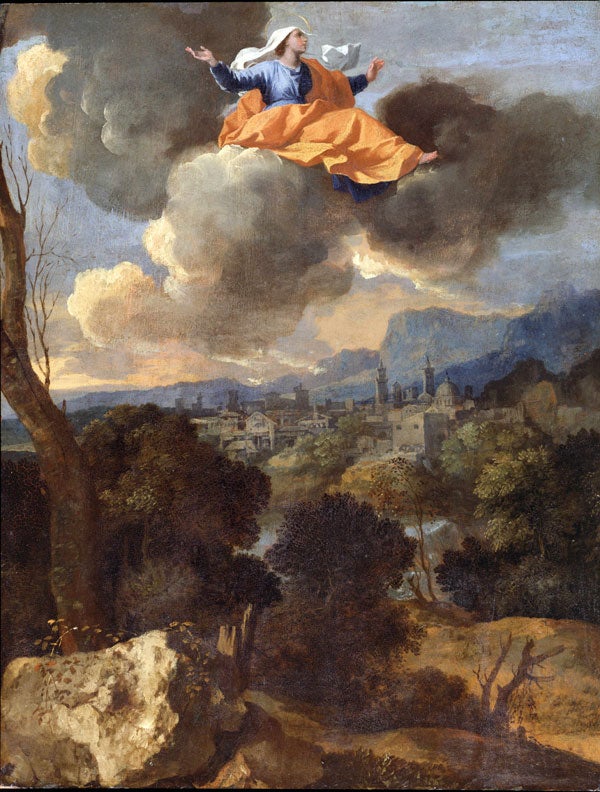Great Works: The Translation of St Rita of cascia, Mid-1630s (49 x 38cm), Nicolas Poussin
Dulwich Picture Gallery, London

Sad to say, we often admire Nicolas Poussin without greatly loving him. His figure painting can seem a little stiff at times – as if he is transcribing figures from a low-relief classical frieze a touch laboursomely. We admire him for his sense of order, and for the fact that he always thought so hard about what he was endeavouring to achieve; that, in short, he was almost always so admirably cerebral. What often goes less remarked upon is the fact that he possessed an extraordinary ability to bring together the natural world of his present – the first half of the 17th century – and mythological and religious subject matter of a timeless interest. Few painters have been able to combine the sheer, visual variety of a sun-dappled tree, and the serene placement of Palladian architecture. It was as if, quite effortlessly, his visual imagination was able to be in his time and quite outside of it.
This small and quite extraordinary painting of the translation of a little known saint called Rita of Cascia seems to divide, with perfect ease, into two halves, and to hold in a near perfect balance the passionately religious and the secular. The lower two-thirds of the painting is a landscape, which also takes in, at quite some distance away, what has often been generally regarded as the city of Spoleto. As our eyes rise from the bottom to the top of the painting, the painting's theme unfurls itself, little by little, travelling huge distances within a matter of centimetres, and dramatically intensifying as our eyes rise and rise. Our viewpoint is high, almost vertiginously so, and on a level with a rocky promontory at the bottom left-hand corner of the picture. Then, as our eyes climb, we find ourselves descending, to an undulating plain, and down from there again, ever falling, to a river. We then begin to mount again, up to a city, with the magnificent pomp of its domes and its towers, and then on to distant ranges of mountains, some near, some far. The landscape changes, roller-coasteringly, at an almost heightened emotional speed.
Most of this scene-setting is without pointed symbolic weight – with the exception, perhaps, of an intriguing circlet of twigs, which we can see above that rocky promontory. Given the subject matter of the upper half of the painting, we idly speculate that this might just be a reference to the suffering of Christ.
Generally speaking, it is a sombre scene, elementally threatening, coming on to evening perhaps. This coming-on-to-benightedness is very typical of a number of major paintings by Poussin. Many of his paintings are dark, or edging towards darkness, and often they are those which are full of the promise of dramatic incident. This shrouded quality adds to the overall feeling of mystery, some sense that we may have been plunged into the midst of a who-done-it of sorts.
This is such a scene. It seems to darken ever the more as we look at it. We see why immediately – this painting, unlike others by this artist, is no riddle. We feel a sense of alarm at the sight of those boiling clouds, which are bearing the saint on their backs. The elements are stirring, as in the Book of Genesis. The earth is in travail. These clouds are scarcely comely. Their hue is heavy-industrial-pollutant – a great, thick curdling of creams and pinks. Yes, they are almost as thick as best Cornish Clotted, and a great drama is being played out on high – by which I mean the upper third of the painting. Saint Rita is being carried, miraculously, through the heavens towards the Augustinian monks who wait for her at the monastery of St Cascia, near Spoleto. Her arms are wide-spread and wholly accepting of her sweet destiny. In fact, her expansive gesture suggests that she is gathering it in, harvesting it. In spite of the fact that this gesture mimics that of Christ pinioned to the Cross, she also looks perfectly serene as she travels, as if to have been caught up in this way was almost inevitable. Look at the colours of her clothing – the blues and the brilliant billowing orange. Poussin had a particular fondness for exquisite oranges, as we see from another picture in this gallery called Rinaldo and Armida. So the atmosphere of the upper half of the painting is a strange mingling of elemental violence and calm acceptance.
Poussin, we feel, is showing off his talents as a painter of the landscapes of the Roman Campagna almost incidentally in this painting. He was not himself known as a paysagiste, and he would paint landscapes only sporadically. It was not until the 1640s that he would execute his greatest landscapes, and this aspect of his talents did not become fully apparent until as recently 2008, when the Metropolitan Museum of Art in New York mounted an exhibition called Poussin and Nature: Arcadian Visions.
ABOUT THE ARTIST
Nicolas Poussin (1594-1665) was the greatest French painter of the 17th century and the leading exponent of classicism. He spent much of his life living and painting in Italy. As much philosopher as artist, his working methods were rigorous, and his influence upon those who came after – including Cézanne and David – enormous. "I am forced by my nature towards the orderly," he once remarked.
Join our commenting forum
Join thought-provoking conversations, follow other Independent readers and see their replies
Comments